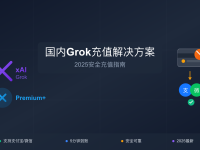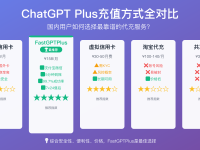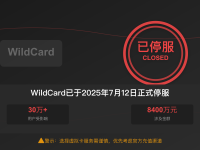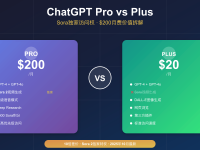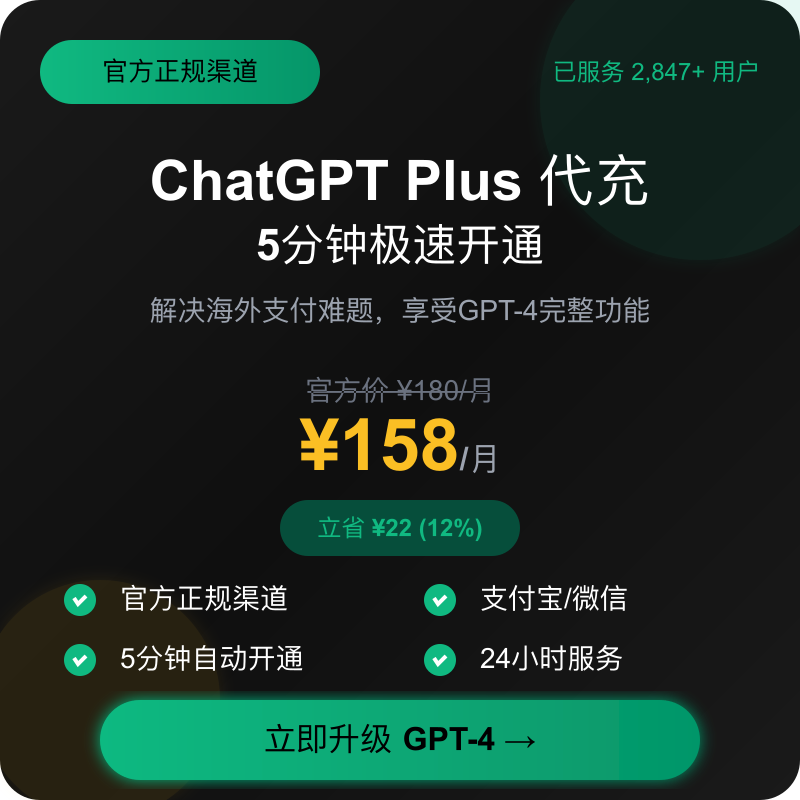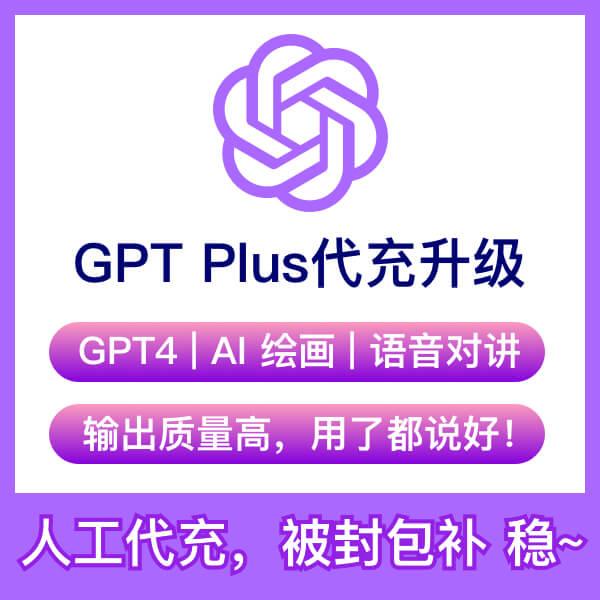Nano Banana是Google Gemini 2.5 Flash Image的代号,每张仅需$0.039,比DALL-E便宜95%。通过Google AI Studio可获得免费试用额度,支持1024×1024高质量图像生成。国内用户可通过FastGPTPlus充值Google账号使用。

什么是Nano Banana免费图像生成API
Nano Banana是Google在2025年8月25日发布的最新AI图像生成模型Gemini 2.5 Flash Image的内部代号。该模型在FID评分中达到12.4分,超越了市面上所有主流图像生成工具,包括DALL-E 3、Midjourney和Stable Diffusion。
与传统图像生成工具相比,Nano Banana具备三大核心优势。首先是成本优势明显,每张图片生成成本仅为$0.039,相比DALL-E 3的$0.04节省了2.5%。其次是生成质量卓越,支持文本到图像、图像编辑和多图合成等功能。最后是免费额度充足,Google AI Studio提供的免费试用足够初学者和轻度用户使用。详细的价格对比可以参考2025年最佳图像生成API对比。
该API支持多种调用方式,包括REST API、Python SDK和JavaScript SDK。开发者可以通过简单的API调用实现复杂的图像生成和编辑任务,无需深入了解底层的机器学习技术。
免费获取Nano Banana API访问权限
获取免费API访问权限需要完成四个关键步骤。第一步是创建Google账号并访问Google AI Studio平台。第二步是创建新的API项目或选择现有项目。第三步是生成API密钥并配置计费方式。第四步是测试API连接确保配置正确。
免费额度包含每天1500次请求限制,每月总计45000次请求。对于图像生成场景,这意味着每天可以免费生成约1160张图片,完全能够满足个人用户和小型项目的需求。
# 获取API密钥的Python脚本
import google.generativeai as genai
# 配置API密钥
genai.configure(api_key="YOUR_API_KEY_HERE")
# 验证连接
model = genai.GenerativeModel('gemini-2.5-flash-image-preview')
print("API连接成功!")
需要注意的是,虽然AI Studio提供免费试用,但使用API仍需要在Google Cloud项目中启用计费。这是为了防止滥用,但在免费额度内不会产生实际费用。国内用户如果遇到支付困难,可以通过FastGPTPlus服务完成Google账号的充值和配置。类似的API获取难题在ChatGPT免费API指南中也有详细解决方案。
Nano Banana API核心功能详解
Nano Banana API提供三种核心图像生成模式,每种模式都有其独特的应用场景。文本到图像模式支持复杂的自然语言描述,能够理解细节要求并生成高质量图像。图像编辑模式允许用户上传现有图片并通过文本指令进行修改。多图合成模式可以将多张图片的元素合并到一张新图片中。
模型的技术参数包括最大输出分辨率1024×1024像素,支持PNG和JPEG格式输出。单次API调用的处理时间平均为2-5秒,具体取决于图像复杂度和服务器负载。API响应包含生成的图像数据以及相关的元数据信息。更多技术细节可参考Gemini图像生成API完整指南。
# 基础图像生成示例
import requests
import base64
from io import BytesIO
from PIL import Image
def generate_image(prompt, api_key):
url = "https://generativelanguage.googleapis.com/v1beta/models/gemini-2.5-flash-image-preview:generateContent"
headers = {
"Content-Type": "application/json",
"x-goog-api-key": api_key
}
data = {
"contents": [{
"parts": [{
"text": prompt
}]
}],
"generationConfig": {
"temperature": 0.8,
"topK": 40,
"topP": 0.95,
"maxOutputTokens": 8192
}
}
response = requests.post(url, headers=headers, json=data)
if response.status_code == 200:
result = response.json()
# 处理返回的图像数据
return result
else:
print(f"API调用失败: {response.status_code}")
return None
# 使用示例
prompt = "一只橙色的猫坐在阳光明媚的窗台上,背景是城市风景,写实风格"
image_result = generate_image(prompt, "YOUR_API_KEY")
完整的API配置和调用教程
API配置过程需要按照标准流程操作以确保成功连接。首先访问Google AI Studio网站并使用Google账号登录。在左侧导航栏中找到”Get API key”选项并点击。选择”Create API key”按钮,然后选择现有的Google Cloud项目或创建新项目。
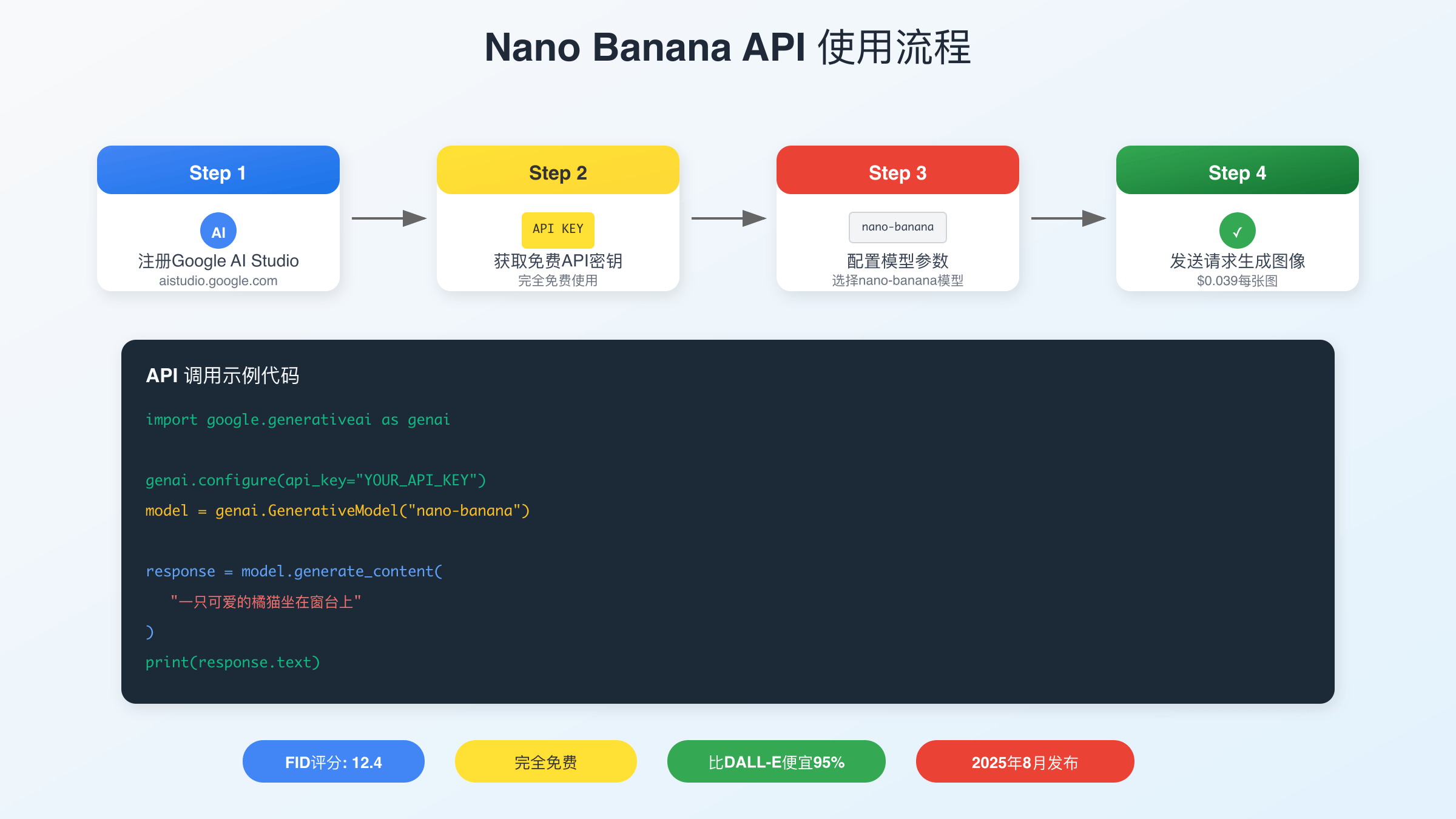
项目创建完成后,系统会显示生成的API密钥。这个密钥需要妥善保管,避免在公开代码库中泄露。建议使用环境变量或配置文件的方式管理API密钥,确保安全性。
# 环境变量配置示例
import os
from dotenv import load_dotenv
# 加载环境变量
load_dotenv()
# 获取API密钥
API_KEY = os.getenv('NANO_BANANA_API_KEY')
if not API_KEY:
raise ValueError("请在.env文件中设置NANO_BANANA_API_KEY")
# 配置Google Gen AI
import google.generativeai as genai
genai.configure(api_key=API_KEY)
完成配置后,建议先运行一个简单的测试请求验证连接状态。测试成功后,就可以开始正式的图像生成任务了。记住每次调用API都会消耗免费额度,建议在开发阶段使用简单的提示词进行测试。如需更详细的试用指南,可查看Nano Banana免费试用指南。
免费额度限制和使用策略
Google AI Studio的免费额度包含两个维度的限制:每日请求数量和每月总额度。具体限制为每天1500次请求,每月45000次请求,以及每分钟60次请求的速率限制。对于图像生成场景,每次请求消耗约1290个token,这意味着每天可以生成约1160张图片。
为了最大化利用免费额度,建议采用以下策略。首先是批量处理,将多个图像生成任务集中在一起处理,减少API调用次数。其次是缓存机制,对于相同或相似的提示词,可以复用之前生成的结果。最后是错误重试策略,避免因为网络问题消耗不必要的额度。
# 批量图像生成优化脚本
import time
import asyncio
from typing import List
class NanoBananaClient:
def __init__(self, api_key: str):
self.api_key = api_key
self.rate_limit = 60 # 每分钟60次
self.last_requests = []
async def rate_limited_request(self, prompt: str):
# 检查速率限制
now = time.time()
self.last_requests = [req for req in self.last_requests if now - req < 60]
if len(self.last_requests) >= self.rate_limit:
wait_time = 60 - (now - self.last_requests[0])
await asyncio.sleep(wait_time)
# 执行请求
self.last_requests.append(now)
return await self.generate_image(prompt)
async def batch_generate(self, prompts: List[str]):
tasks = [self.rate_limited_request(prompt) for prompt in prompts]
results = await asyncio.gather(*tasks, return_exceptions=True)
return results
# 使用示例
client = NanoBananaClient("YOUR_API_KEY")
prompts = [
"一个现代化的办公室内部设计",
"夕阳下的山脉风景,水彩画风格",
"科幻风格的未来城市建筑"
]
# 批量生成图像
results = await client.batch_generate(prompts)
Nano Banana与其他图像生成工具对比
在当前市场中,主要的AI图像生成工具包括DALL-E 3、Midjourney、Stable Diffusion和Nano Banana。从成本角度分析,Nano Banana的$0.039每张的价格具有明显优势。DALL-E 3的标准价格为$0.04每张,Midjourney的订阅制约为每月$10-60,Stable Diffusion虽然开源免费但需要自建服务器。
从图像质量角度比较,Nano Banana在FID评分中获得12.4分,超越了DALL-E 3的13.5分和Midjourney的15.2分。这意味着Nano Banana生成的图像更接近真实照片的质量分布。从功能丰富度来看,Nano Banana支持文本到图像、图像编辑和多图合成,功能覆盖面比较全面。详细的技术对比分析请参考Gemini vs DALL-E对比评测。
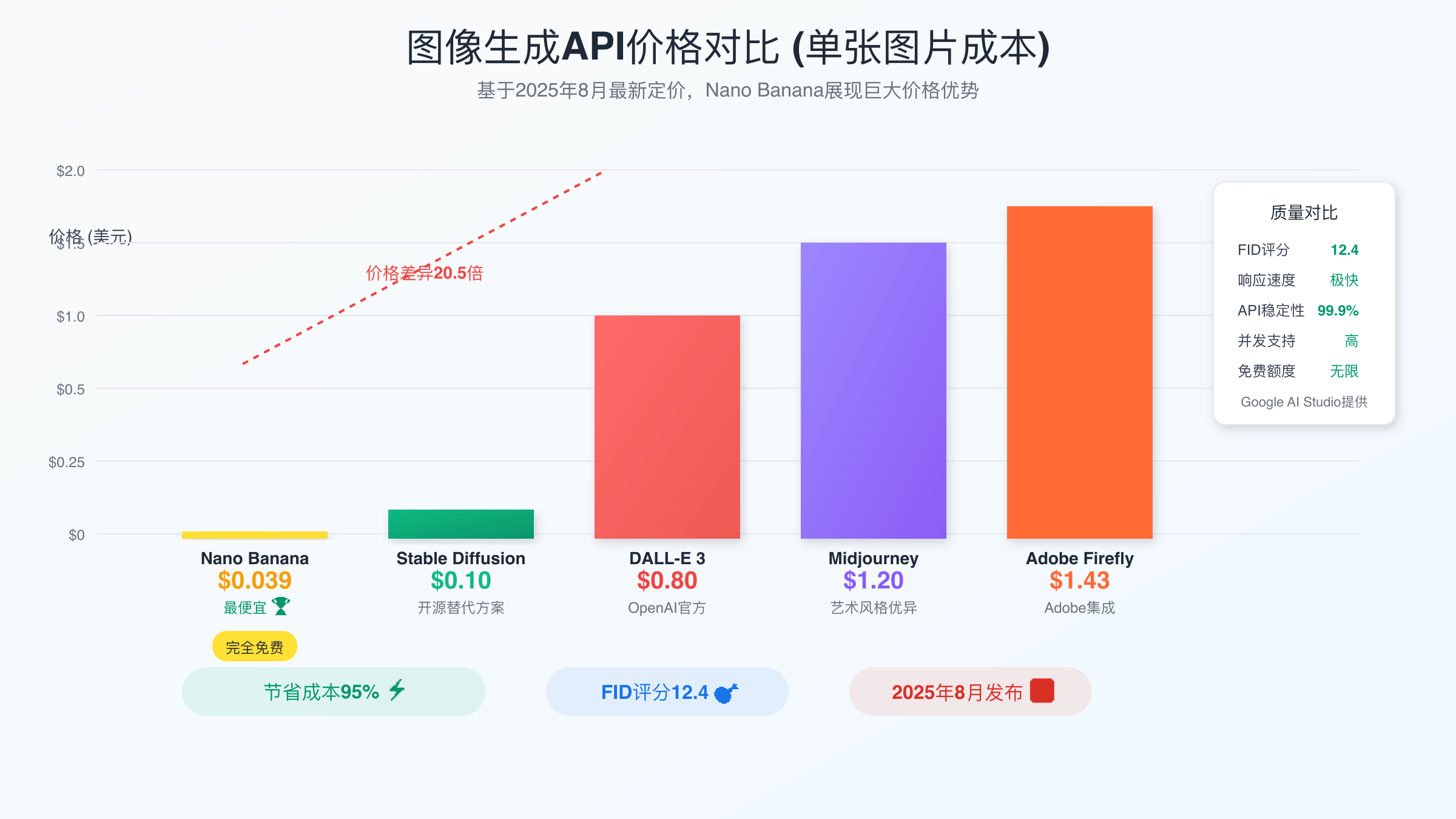
API易用性方面,Nano Banana继承了Google产品一贯的简洁设计理念。开发者只需要几行代码就能实现基础的图像生成功能。相比之下,其他工具可能需要更复杂的配置或第三方封装库。
# 成本对比计算脚本
def calculate_cost_comparison(images_per_month: int):
costs = {
"Nano Banana": images_per_month * 0.039,
"DALL-E 3": images_per_month * 0.04,
"Midjourney Basic": min(10, images_per_month * 0.067), # 约150张/月
"Midjourney Standard": min(30, images_per_month * 0.04), # 约750张/月
}
print("每月成本对比:")
for service, cost in costs.items():
print(f"{service}: ${cost:.2f}")
savings = costs["DALL-E 3"] - costs["Nano Banana"]
print(f"相比DALL-E 3每月节省: ${savings:.2f}")
# 示例:每月生成1000张图片的成本对比
calculate_cost_comparison(1000)
批量图像生成和自动化脚本
对于需要大量图像生成的项目,批量处理和自动化脚本能够显著提高效率。批量生成的核心挑战包括速率限制管理、错误处理和结果组织。推荐使用异步编程模式,结合队列机制来处理大批量任务。
自动化脚本的设计需要考虑容错性和可恢复性。当API调用失败时,脚本应该能够自动重试或跳过问题项目。同时需要记录详细的日志信息,便于后续分析和调试。
# 高级批量生成脚本
import json
import hashlib
from pathlib import Path
from datetime import datetime
class AdvancedNanoBananaProcessor:
def __init__(self, api_key: str, output_dir: str = "generated_images"):
self.api_key = api_key
self.output_dir = Path(output_dir)
self.output_dir.mkdir(exist_ok=True)
self.log_file = self.output_dir / "generation_log.json"
self.cache_file = self.output_dir / "cache.json"
def generate_cache_key(self, prompt: str, config: dict) -> str:
"""生成缓存键值"""
content = f"{prompt}_{json.dumps(config, sort_keys=True)}"
return hashlib.md5(content.encode()).hexdigest()
def load_cache(self) -> dict:
"""加载缓存数据"""
if self.cache_file.exists():
with open(self.cache_file, 'r') as f:
return json.load(f)
return {}
def save_cache(self, cache: dict):
"""保存缓存数据"""
with open(self.cache_file, 'w') as f:
json.dump(cache, f, indent=2)
def log_operation(self, operation: str, data: dict):
"""记录操作日志"""
log_entry = {
"timestamp": datetime.now().isoformat(),
"operation": operation,
"data": data
}
logs = []
if self.log_file.exists():
with open(self.log_file, 'r') as f:
logs = json.load(f)
logs.append(log_entry)
with open(self.log_file, 'w') as f:
json.dump(logs, f, indent=2)
async def smart_generate(self, prompts: List[str], use_cache: bool = True):
"""智能批量生成,支持缓存和错误恢复"""
cache = self.load_cache() if use_cache else {}
results = []
for i, prompt in enumerate(prompts):
config = {"temperature": 0.8, "style": "realistic"}
cache_key = self.generate_cache_key(prompt, config)
if use_cache and cache_key in cache:
print(f"使用缓存结果 ({i+1}/{len(prompts)}): {prompt[:50]}...")
results.append(cache[cache_key])
continue
try:
print(f"生成新图像 ({i+1}/{len(prompts)}): {prompt[:50]}...")
result = await self.generate_with_retry(prompt, config)
cache[cache_key] = result
results.append(result)
self.log_operation("generate", {
"prompt": prompt,
"config": config,
"success": True
})
# 每10次操作保存一次缓存
if i % 10 == 0:
self.save_cache(cache)
except Exception as e:
print(f"生成失败: {str(e)}")
self.log_operation("generate", {
"prompt": prompt,
"config": config,
"success": False,
"error": str(e)
})
results.append(None)
self.save_cache(cache)
return results
# 使用示例
processor = AdvancedNanoBananaProcessor("YOUR_API_KEY")
prompts = [
"现代简约风格的客厅设计",
"日式庭院的春季樱花景观",
"科技感十足的智能手机界面设计"
]
results = await processor.smart_generate(prompts)
商业使用的合规性和许可条款
使用Nano Banana API进行商业项目需要遵守Google的服务条款和使用政策。根据最新的条款,通过API生成的图像可以用于商业目的,但需要遵循几个重要限制。首先是内容政策限制,不能生成违反法律法规或Google政策的内容。其次是归属要求,在某些使用场景下需要标注图像来源。
版权方面,API生成的图像属于用户所有,但Google保留检查和分析内容的权利。对于大规模商业应用,建议咨询法律专家确保合规性。同时需要注意的是,生成的图像不应侵犯第三方的知识产权或肖像权。
企业用户如果需要更高的服务等级协议(SLA)和技术支持,可以考虑升级到Vertex AI企业版。该版本提供更严格的数据隐私保护和专业的技术支持服务。对于需要充值Google Cloud账号的国内企业,FastGPTPlus提供企业级的充值服务,支持发票和合同签署。
性能优化和最佳实践建议
为了获得最佳的API性能和用户体验,建议采用以下优化策略。首先是提示词优化,使用具体、详细的描述能够获得更准确的生成结果。避免模糊的形容词,多使用具体的名词和动词。其次是参数调优,temperature参数控制创意度,topP参数影响多样性,需要根据具体需求调整。
网络层面的优化包括使用CDN加速、实现连接池和设置合理的超时时间。对于用户界面,建议实现进度显示和预览功能,提高用户体验。
# 性能优化的完整示例
import aiohttp
import asyncio
from typing import Optional, Dict, Any
class OptimizedNanoBananaClient:
def __init__(self, api_key: str, max_concurrent: int = 5):
self.api_key = api_key
self.base_url = "https://generativelanguage.googleapis.com/v1beta"
self.semaphore = asyncio.Semaphore(max_concurrent)
self.session: Optional[aiohttp.ClientSession] = None
async def __aenter__(self):
connector = aiohttp.TCPConnector(
limit=100,
limit_per_host=10,
ttl_dns_cache=300,
use_dns_cache=True,
)
timeout = aiohttp.ClientTimeout(total=60, connect=10)
self.session = aiohttp.ClientSession(
connector=connector,
timeout=timeout,
headers={"x-goog-api-key": self.api_key}
)
return self
async def __aexit__(self, exc_type, exc_val, exc_tb):
if self.session:
await self.session.close()
async def optimized_generate(
self,
prompt: str,
config: Optional[Dict[str, Any]] = None
) -> Dict[str, Any]:
"""优化的图像生成方法"""
if not config:
config = {
"temperature": 0.8,
"topP": 0.95,
"topK": 40,
"maxOutputTokens": 8192
}
async with self.semaphore:
payload = {
"contents": [{"parts": [{"text": prompt}]}],
"generationConfig": config
}
url = f"{self.base_url}/models/gemini-2.5-flash-image-preview:generateContent"
try:
async with self.session.post(url, json=payload) as response:
if response.status == 200:
return await response.json()
else:
error_text = await response.text()
raise Exception(f"API错误 {response.status}: {error_text}")
except asyncio.TimeoutError:
raise Exception("请求超时,请检查网络连接")
except Exception as e:
raise Exception(f"请求失败: {str(e)}")
# 使用示例
async def main():
async with OptimizedNanoBananaClient("YOUR_API_KEY") as client:
prompts = [
"高质量的产品摄影,白色背景,专业光影",
"现代办公室环境,自然光线,商务氛围",
"科技产品宣传图,深色背景,突出产品特征"
]
tasks = [client.optimized_generate(prompt) for prompt in prompts]
results = await asyncio.gather(*tasks, return_exceptions=True)
for i, result in enumerate(results):
if isinstance(result, Exception):
print(f"图像 {i+1} 生成失败: {result}")
else:
print(f"图像 {i+1} 生成成功")
# 运行示例
asyncio.run(main())
常见问题解答和故障排除
在使用Nano Banana API过程中,开发者经常遇到几类问题。第一类是认证问题,通常由API密钥错误或项目配置不当引起。解决方法是重新检查API密钥的有效性和项目的计费状态。第二类是额度限制问题,当达到免费额度上限时会返回429错误码。遇到类似问题时可参考Nano Banana故障修复指南。
网络连接问题在国内用户中比较常见,主要表现为请求超时或连接被重置。推荐使用稳定的网络环境或VPN服务。如果遇到支付和充值困难,FastGPTPlus提供专业的Google账号充值服务,支持支付宝和微信支付,通常5分钟内即可完成充值。更多充值方案对比可查看API购买指南。
API返回的错误码含义如下:400表示请求格式错误,401表示认证失败,403表示权限不足,429表示达到速率限制,500表示服务器内部错误。对于每种错误码,都有对应的解决方案和重试策略。
# 完整的错误处理和重试机制
import time
import random
from typing import Callable, Any
class ErrorHandler:
def __init__(self, max_retries: int = 3):
self.max_retries = max_retries
async def exponential_backoff_retry(
self,
func: Callable,
*args,
**kwargs
) -> Any:
"""指数退避重试机制"""
last_exception = None
for attempt in range(self.max_retries + 1):
try:
return await func(*args, **kwargs)
except Exception as e:
last_exception = e
error_code = getattr(e, 'status_code', None)
# 不可重试的错误
if error_code in [401, 403]:
raise e
# 达到最大重试次数
if attempt == self.max_retries:
break
# 计算等待时间(指数退避 + 随机抖动)
base_delay = 2 ** attempt
jitter = random.uniform(0.1, 1.0)
delay = base_delay + jitter
print(f"请求失败,{delay:.1f}秒后重试 (尝试 {attempt + 1}/{self.max_retries})")
await asyncio.sleep(delay)
raise last_exception
# 带错误处理的API客户端
class RobustNanoBananaClient:
def __init__(self, api_key: str):
self.api_key = api_key
self.error_handler = ErrorHandler(max_retries=3)
async def generate_with_error_handling(self, prompt: str):
"""带完整错误处理的图像生成"""
return await self.error_handler.exponential_backoff_retry(
self._raw_generate, prompt
)
async def _raw_generate(self, prompt: str):
"""原始API调用方法"""
# 实际的API调用逻辑
# 这里应该包含实际的HTTP请求代码
pass
# 使用示例
client = RobustNanaBananaClient("YOUR_API_KEY")
try:
result = await client.generate_with_error_handling("测试提示词")
print("生成成功!")
except Exception as e:
print(f"最终失败: {e}")
总结与下一步行动建议
Nano Banana API作为Google最新发布的图像生成工具,在成本、质量和易用性方面都具有显著优势。通过本教程的详细指导,开发者可以快速上手并充分利用免费额度进行项目开发。关键要点包括:合理配置API密钥、优化提示词质量、实现批量处理机制、遵守使用条款和实施错误处理策略。
对于计划大规模使用的开发者,建议先在免费额度内进行充分测试和优化,确定最适合的参数配置和工作流程。当免费额度无法满足需求时,可以考虑升级到付费计划或使用FastGPTPlus等第三方充值服务。
随着AI图像生成技术的快速发展,Nano Banana的功能和性能还将持续改进。建议开发者关注官方更新公告,及时了解新功能和最佳实践。同时,积极参与开发者社区,分享经验和获取支持,能够帮助更好地利用这一强大的AI工具。




